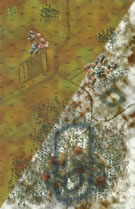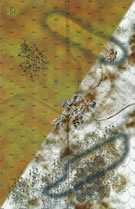|
|
|
Total |
| Side 1 |
0 |
| Draw |
0 |
| Side 2 |
0 |
|
Total |
| Side 1 |
0 |
| Draw |
0 |
| Side 2 |
0 |
|
Total |
| Side 1 |
0 |
| Draw |
0 |
| Side 2 |
0 |
|
| Overall Rating, 0 votes |
|---|
|
|
|
Scenario Rank:
--- of 966 |
| Parent Game |
Dragon’s Teeth |
| Historicity |
Historical |
| Date |
1944-11-16 |
| Start Time |
12:45 |
| Turn Count |
16 |
| Visibility |
Day |
| Counters |
47 |
| Net Morale |
0 |
| Net Initiative |
1 |
| Maps |
2: 23, 24 |
| Layout Dimensions |
86 x 28 cm
34 x 11 in |
| Play Bounty |
217 |
| AAR Bounty |
223 |
| Total Plays |
0 |
| Total AARs |
0 |
| Duplicates |
InoG029, RoRB004 |
|
Introduction
|
|
The North Carolina National Guard's 119th Infantry Regiment was under-strength because one of its battalions had been detached to provide infantry support for the 2nd Armored Division. With the other two regiments of 30th Infantry Division at full strength and well-rested, it was surprising when the 119th was given the job of securing Wurselen.
|
|
Conclusion
|
|
The plans called for the entire 3rd Battalion of the 119th to attack, with Company L detailed to secure Wurselen. They would receive the support of an entire company of Shermans once they cleared the first crossroads in town. But despite starting less than 1,000 yards away they never reached the crossroads. Company L was stymied in every attempt to move forward, while absorbing numerous casualties. Things didn't go much better for Companies I and K, which inched forward but were unable to seriously threaten the town. Thankfully, they suffered far fewer casualties.
|
Display Relevant AFV Rules
| AFV Rules Pertaining to this Scenario's Order of Battle |
- Vulnerable to results on the Assault Combat Chart (7.25, 7.63, ACC), and may be attacked by Anti-Tank fire (11.2, DFT). Anti-Tank fire only affects the individual unit fired upon (7.62, 11.0).
- AFV's are activated by tank leaders (3.2, 3.3, 5.42, 6.8).
They may also be activated as part of an initial activating stack, but if activated in this way would need a tank
leader in order to carry out combat movement.
- AFV's do not block Direct Fire (10.1).
- Full-strength AFV's with "armor efficiency" may make two anti-tank (AT) fire attacks per turn
(either in their action segment or during opportunity fire) if they have AT fire values of 0 or more
(11.2).
- Each unit with an AT fire value of 2 or more may fire at targets at a distance of between 100% and 150% of its
printed AT range. It does so at half its AT fire value. (11.3)
- Efficient and non-efficient AFV's may conduct two opportunity fires per turn if using direct fire
(7.44, 7.64).
Units with both Direct and AT Fire values may use either type of fire in the same turn as their opportunity fire,
but not both (7.22, 13.0).
Units which can take opportunity fire twice per turn do not have to target the same unit both times (13.0).
- Demoralized AFV's are not required to flee from units that do not have AT fire values (14.3).
- Place a Wreck marker when an AFV is eliminated in a bridge or town hex (16.3).
- AFV's do not benefit from Entrenchments (16.42).
- AFV's may Dig In (16.2).
- Closed-top AFV's: Immune to M, M1 and M2 results on Direct and Bombardment Fire Tables. Do not take step losses from Direct or Bombardment Fire. If X or #X result on Fire Table, make M morale check instead (7.25, 7.41, 7.61, BT, DFT).
- Closed-top AFV's: Provide the +1 modifier on the Assault Table when combined with infantry. (Modifier only applies to Germans in all scenarios; Soviet Guards in scenarios taking place after 1942; Polish, US and Commonwealth in scenarios taking place after 1943.) (ACC)
- Tank: all are closed-top and provide the +1 Assault bonus, when applicable
|
United States Order of Battle
| 1 Errata Item |

|
The reduced direct fire value of the Heer HMG became 5-5 starting with Fall of France.
|





 DrnT024
DrnT024 
























